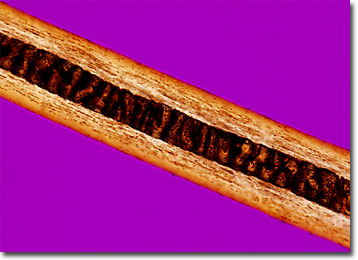Polarized Light Microscopy Digital Image Gallery
Skunk Hair
Though species vary in size and habitat preference, all skunks possess distinctive black and white fur patterns that make them some of the most readily identifiable animals in the Western Hemisphere. Identification of these members of the weasel family Mustelidae by humans and other animals is particularly important because they are liable to spray those that inadvertently approach them.

View a second image of Skunk Hair
The offensive spray of skunks is an oily, yellowish liquid that is produced by the scent glands and ejected from openings under the tail, creating a fine mist. This mist, however, is emitted with great force and may reach targets as many as 12 feet away. In addition to producing a foul odor, skunk spray may cause watery eyes and coughing fits. With such a powerful defense system in their possession, skunks are rather fearless creatures that frequently walk about in open spaces. They are readily tamed, however, and are sometimes utilized as pets, though typically only after their scent glands have been removed.
There are 11 known species of skunks, some of which are also commonly referred to as polecats. The most common varieties in the United States are two species of spotted skunks, which are both members of the genus Spilogale, and the striped skunk, which is scientifically described as Mephitis mephitis. These skunk types, as well as most others, are nocturnal and primarily feed upon birds, insects, worms, rodents, eggs, and plant matter. They typically live as groups or families in dens formed from underground burrows, but may also inhabit barns, woodpiles, haystacks, rocky crevices, and similar locales.
